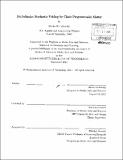| dc.contributor.advisor | Neil Gershenfeld. | en_US |
| dc.contributor.author | Lobovsky, Maxim B | en_US |
| dc.contributor.other | Massachusetts Institute of Technology. Dept. of Architecture. Program in Media Arts and Sciences. | en_US |
| dc.date.accessioned | 2012-03-16T16:04:35Z | |
| dc.date.available | 2012-03-16T16:04:35Z | |
| dc.date.copyright | 2011 | en_US |
| dc.date.issued | 2011 | en_US |
| dc.identifier.uri | http://hdl.handle.net/1721.1/69804 | |
| dc.description | Thesis (S.M.)--Massachusetts Institute of Technology, School of Architecture and Planning, Program in Media Arts and Sciences, 2011. | en_US |
| dc.description | Cataloged from PDF version of thesis. | en_US |
| dc.description | Includes bibliographical references (p. 57-59). | en_US |
| dc.description.abstract | The vision of programmable matter is to create a blob of material that can transform itself into an arbitrary form. One promising approach for achieving programmable matter is to construct a chain of identical nodes that can fold into arbitrary threedimensional shapes. Previous active electromechanical systems have demonstrated this concept but are currently costly, complex, and not robust enough to scale to smaller sizes or larger numbers of nodes. The goal of this thesis is to explore methods of simplifying chain programmable matter by removing the actuator from each node and, instead, putting energy into the system externally through stochastic vibrations. Each node takes this random energy input and rectifies it to produce motion towards the target position. We propose two variants of this system: 1) smart clutches that can be reprogrammed in situ and fold through arbitrary paths in configuration space and 2) ratchets that are programmed ahead of time and are entirely passive. We developed a chain using the ratchet concept and also constructed a new active, electromechanical chain with reduced cost and improved speed and torque compared to previous electromechanical systems. Through experimental and computer simulated studies, we determined that stochastic actuation can simplify and reduce the cost of these systems. We have also identified how the size of the increments of the ratchet, length of the chain, and the amplitude and frequency of agitation affect the folding time and success rate. In addition, we show that passive folding systems should improve in performance as the hardware scales down. | en_US |
| dc.description.statementofresponsibility | by Maxim B. Lobovsky. | en_US |
| dc.format.extent | 59 p. | en_US |
| dc.language.iso | eng | en_US |
| dc.publisher | Massachusetts Institute of Technology | en_US |
| dc.rights | M.I.T. theses are protected by
copyright. They may be viewed from this source for any purpose, but
reproduction or distribution in any format is prohibited without written
permission. See provided URL for inquiries about permission. | en_US |
| dc.rights.uri | http://dspace.mit.edu/handle/1721.1/7582 | en_US |
| dc.subject | Architecture. Program in Media Arts and Sciences. | en_US |
| dc.title | RattleSnake : stochastic folding for chain programmable matter | en_US |
| dc.title.alternative | Rattle snake | en_US |
| dc.title.alternative | Stochastic folding for chain programmable matter | en_US |
| dc.type | Thesis | en_US |
| dc.description.degree | S.M. | en_US |
| dc.contributor.department | Program in Media Arts and Sciences (Massachusetts Institute of Technology) | |
| dc.identifier.oclc | 777964190 | en_US |
